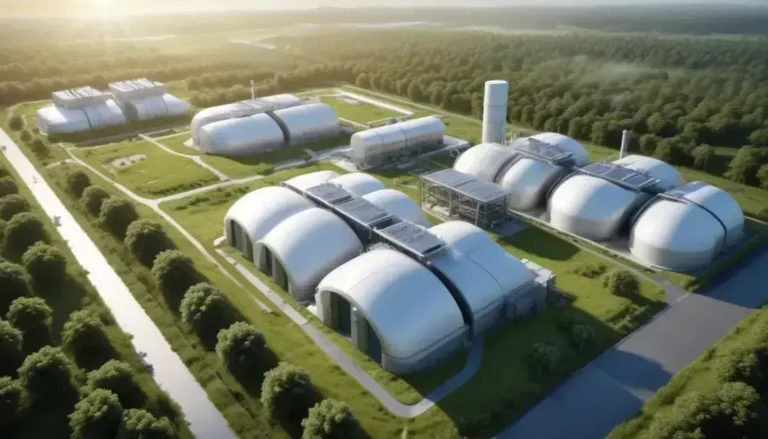Kathleen McLaughlin: Leading Walmart’s Green Initiatives
Walmart’s sustainability efforts, led by Kathleen McLaughlin, focus on reducing greenhouse gas emissions, promoting renewable energy, and implementing initiatives like Project Gigaton to create a significant positive environmental impact.
Walmart sustainability is at the forefront of corporate responsibility, driven by leaders like Kathleen McLaughlin. How does her vision shape the future of retail?
Understanding Kathleen McLaughlin’s Role at Walmart
Kathleen McLaughlin plays a pivotal role in advancing sustainability initiatives at Walmart, steering the company towards a greener future. As the Chief Sustainability Officer, she is responsible for integrating environmentally friendly practices across all levels of the organization. Her leadership focuses on ambitious goals that include reducing greenhouse gas emissions and promoting sustainable sourcing.
Vision for Sustainability: McLaughlin’s vision emphasizes transparency and accountability in Walmart’s operations. She advocates for substantive commitments to renewable energy, aiming for a 100% renewable energy supply chain. This initiative not only enhances Walmart’s corporate responsibility but also sets a benchmark for the retail industry.
McLaughlin also leads the charge in implementing innovative solutions that tackle climate change. Under her guidance, Walmart has introduced projects that encourage sustainable agriculture and reduce waste. This holistic approach ensures that Walmart’s sustainability endeavors resonate with its broader mission of making a positive impact on communities.
By collaborating with various stakeholders, including suppliers and local communities, McLaughlin fosters partnerships that amplify sustainability efforts. Her work is instrumental in positioning Walmart as a leader in corporate sustainability, influencing other companies to adopt stronger environmental commitments.
Walmart’s Sustainability Goals and Achievements
Walmart’s commitment to sustainability entails ambitious goals that aim to reduce its environmental footprint significantly. One of the key targets is to achieve zero waste in its operations, focusing on maximizing recycling efforts and minimizing landfill contributions. This initiative is crucial, as it promotes a circular economy and encourages responsible consumption.
Renewable Energy is also at the forefront of Walmart’s sustainability strategy. The company aims to power its global operations with 100% renewable energy by investing in solar, wind, and other clean energy sources. This transition not only cuts down on carbon emissions but also positions Walmart as a leader in the retail industry’s shift towards greener practices.
Additionally, Walmart strives to enhance its sustainable sourcing efforts by partnering with farmers and suppliers committed to eco-friendly practices. This includes priorities such as responsible forestry and sustainable agriculture, ensuring that products offered are not only good for customers but also for the planet.
Through these initiatives, Walmart demonstrates that large corporations can play a pivotal role in fighting climate change. By setting measurable benchmarks and reporting progress, Walmart not only helps the environment but also inspires other businesses to follow suit in their sustainability journeys.
Key Initiatives Led by Kathleen McLaughlin
Kathleen McLaughlin has spearheaded several key initiatives at Walmart that underscore the company’s commitment to sustainability. One notable example is the Project Gigaton, which aims to eliminate one billion metric tons of greenhouse gases from the company’s supply chain by 2030. This ambitious goal encourages suppliers to adopt more eco-friendly practices.
Collaborative Efforts are crucial to McLaughlin’s approach. She emphasizes partnerships with various organizations to promote sustainable agriculture and responsible sourcing. This collaboration helps ensure that Walmart’s products are not only affordable but also ethically sourced and produced.
McLaughlin’s focus on innovation is evident in the launch of new programs aimed at reducing waste. For instance, Walmart has embraced circular economy principles, allowing for the reuse and recycling of materials throughout its operations. This shift not only mitigates environmental impact but also reduces costs.
Furthermore, Kathleen advocates for transparency in sustainability reporting. By sharing progress and challenges, Walmart can set realistic benchmarks while inspiring other corporations to follow suit. Through these initiatives, McLaughlin is shaping the future of retail and demonstrating that sustainable practices can coexist with business profitability.
The Impact of Sustainability on Retail and Society
The impact of sustainability on retail and society is profound, reshaping how businesses operate and how consumers make choices. Retailers that prioritize sustainable practices are not only enhancing their brand image but also meeting the growing demand for eco-friendly products. This shift encourages more companies to adopt green initiatives, contributing to a healthier planet.
By implementing sustainable practices, retailers can reduce operational costs through energy efficiency and waste reduction. For example, utilizing renewable energy sources and optimizing logistics can lead to significant savings. These cost efficiencies ultimately benefit consumers by allowing retailers to offer more competitive pricing.
Moreover, companies focusing on sustainability often experience increased customer loyalty. Modern consumers, particularly younger ones, prioritize brands that align with their values, including environmental responsibility. This results in stronger emotional connections between consumers and brands, which can enhance sales and customer retention.
On a societal level, sustainable retail practices contribute to positive change by promoting ethical sourcing and supporting local economies. This not only creates jobs but also empowers communities. As retailers continue to embrace sustainability, they play a crucial role in driving systemic change, guiding society towards a more sustainable and equitable future.
In summary, the future of retail is green
Walmart’s commitment to sustainability sets a strong example for other companies to follow. With initiatives led by Kathleen McLaughlin, Walmart demonstrates that large retailers can make a significant impact on the environment while also benefiting economically.
As consumers increasingly demand eco-friendly options, businesses that prioritize sustainability are better positioned for success. This not only enhances their brand reputation but also fosters loyalty among customers who care about the planet.
Ultimately, the integration of sustainable practices across the retail sector is vital for creating a healthier society and planet. By working together, retailers and consumers can pave the way for a sustainable future.
Frequently Asked Questions
What initiatives is Walmart undertaking for sustainability?
Walmart is implementing initiatives like Project Gigaton to reduce greenhouse gas emissions from its supply chain and aims for 100% renewable energy.
How does sustainability benefit retail companies?
Sustainability leads to cost savings, improved brand reputation, and increased customer loyalty as consumers prioritize eco-friendly products.
What role does Kathleen McLaughlin play in Walmart’s sustainability efforts?
Kathleen McLaughlin, as Chief Sustainability Officer, leads Walmart’s initiatives in reducing environmental impact and promoting sustainable practices.
Why is consumer demand for sustainable products increasing?
Consumers are becoming more aware of environmental issues and prefer to support brands that demonstrate responsibility towards the planet.
How can retailers contribute to positive societal change through sustainability?
By adopting sustainable practices, retailers can support local economies, create jobs, and promote ethical sourcing of products.
What is the significance of transparency in sustainability reporting?
Transparency builds trust with consumers and other stakeholders, showing commitment to sustainability goals and progress made.






